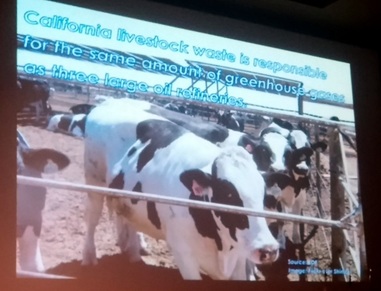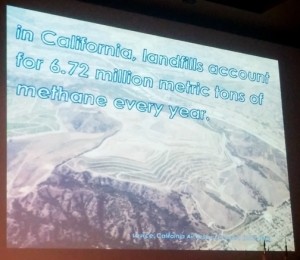Recently the Coalition for Clean Air co-sponsored the California Methane Symposium organized by Climate Resolve and Environmental Defense Fund, and we were delighted to see a crowd of over 100 people interested in learning more about methane. Carbon dioxide (CO2) is the greenhouse gas that gets the most attention these days, but reducing emissions of methane and other short-lived climate pollutants is also vital to our efforts to combat climate change.
Methane might only stay in the atmosphere for 12 years – a stark comparison to the 100-300 years for carbon dioxide – but it is a more potent greenhouse gas because of how it absorbs heat. Pound for pound, methane traps 84 times more heat than carbon dioxide over the first two decades after it is released into the air. Therefore, reducing methane emissions can have relatively quick and tremendous climate benefits in the short-term. Methane also leads to the formation of ground-level ozone, a lung-damaging air pollutant.
Based on ambient readings, most of the methane emissions in the state are attributed to livestock and dairy farms in the Central Valley. They account for almost 60% of the emissions, a result of bacteria decomposing organic materials in manure lagoons and cows’ digestive tracts (this last process is known as enteric fermentation). Rice fields are another significant agricultural source. Methane is also emitted from oil wells and gas pipelines in the form of leaks. Landfills and wastewater treatment plants are responsible for 21% and 4%, respectively, of the state’s emissions. Decomposition of organic waste in landfills is the main source of methane in urban areas like Los Angeles.
Although ambient measurements have helped scientists identify the main culprits of emissions, the challenge arises in pin pointing the specific emission sources and determining accurate measurements. For example, in the Central Valley there are areas where oil fields are in close proximity to agricultural facilities. Currently, it is difficult to conclude whether the oil pump or the farm nearby is emitting the most methane. One of the scientists that spoke at the symposium made the analogy that trying to find a methane leak is like trying to find a smoker in a big room packed with many people. You are only able to locate the smoker when you are close enough to that person to smell the smoke.
 In order to accurately measure methane emissions and identify the exact sources, ongoing research efforts are happening across the state. Emerging remote sensing technology is being used to identify methane super-emitters. Additionally, recent statewide findings suggest that methane emissions were underestimated. Improving and expanding the state’s inventory of emission sources, as well as detecting the super emitters, will be key to identifying and implementing effective reduction strategies that will help California meet its climate goals.
In order to accurately measure methane emissions and identify the exact sources, ongoing research efforts are happening across the state. Emerging remote sensing technology is being used to identify methane super-emitters. Additionally, recent statewide findings suggest that methane emissions were underestimated. Improving and expanding the state’s inventory of emission sources, as well as detecting the super emitters, will be key to identifying and implementing effective reduction strategies that will help California meet its climate goals.
We at CCA understand that along with carbon dioxide and black carbon, methane emissions must be addressed if we want to effectively reduce the impact of climate change in the state. This is why were one of the leading supporters of SB 605 (Lara/Pavley), a bill signed into law last year, which gives the California Air Resources Board (ARB) a deadline and a mandate to formulate a comprehensive
plan to reduce emissions from methane and other short-lived climate pollutants, such as black carbon. We will monitor the development of this plan and advocate for strong reduction measures and incentive mechanisms, and will keep you updated on our efforts.
[share title=”Share This Post”]








